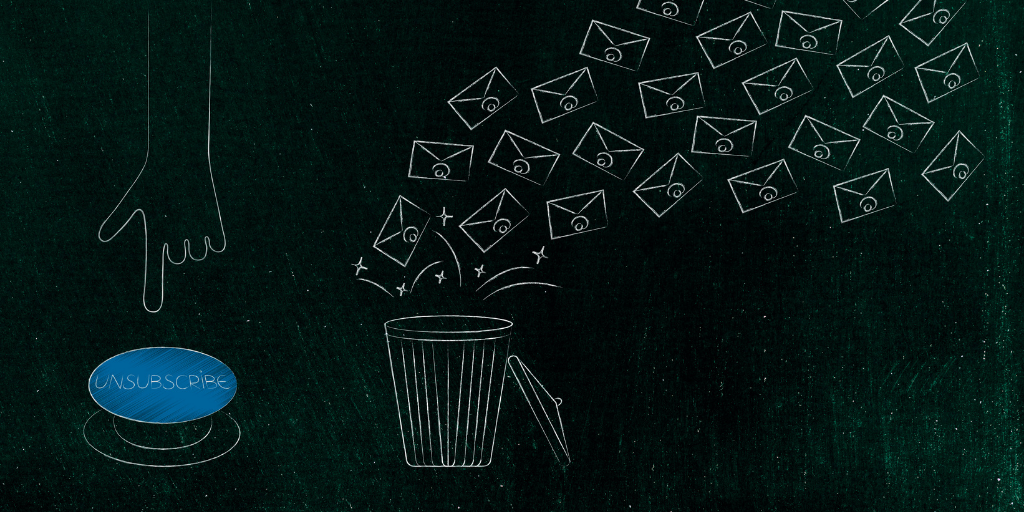Email marketing is something that every brand needs to embrace. Embracing and optimising your email marketing activities can add huge value to your brand. Have you got to grips with the basics of email marketing, but are still losing larger percentages of your readers than you’d like with each email send?
We see companies making so many mistakes, and in the world of email marketing mistakes equal unsubscribes. When marketing lists take so long to grow , high unsubscribes rate are definitely not we want. Avoiding high unsubscribe rates, while seeing good engagement, and providing informative content, requires balance.
With most things in life, we need to establish balance. I like chocolate but I don’t want to only eat chocolate for the rest of my life. I like the Red Hot Chilli peppers, but I don’t want to listen to them on repeat every waking moment. I like sleeping, in fact I need to sleep, but I don’t want to sleep more than 8 hours a night - I don’t want to sleep much less than 8 hours a night either.
Marketing emails are something that people tend to struggle to find this oh so important balance with. Sure, you want to inform your email lists of any updates, product features and exciting news, but you also don’t want them to unsubscribe from too many emails or bad practice. If there’s one sure fire way to irritate your audience, it’s by sending them a constant flow of emails that they a) don’t open and b) don’t find value in.
These are some of our top tips, the dos and don’ts for making sure your email marketing isn’t losing you high proportions of your valuable marketing lists (we should mention that email lists do decay over time naturally, so some level of unsubscribes and bounces is fine – but excessive unsubscribes is what we’re tackling here).
Frequency
The saying quality over quantity couldn’t be much more apt than when it comes to email marketing. It’s not about how many times you can feature in your reader’s inbox, it’s about the quality of the communications you send and the engagement you can get on them.
Simply upping your communication frequency to try to increase engagement is a one-way ticket to an unsubscribe. In fact, the number one reason that people unsubscribe from emails is because they receive too many. Other side effects and symptoms you may experience from sending too many emails include, lower engagement, more complaints, lower sender reputation and higher spam ratings. Safe to say, all are things to avoid at all costs.
However, let’s take a look at the other end of the spectrum – sending too few emails can bring about its own problems too! Studies have shown that two thirds of people who sign up to your email list want to hear from you at least weekly, with around 85% wanting to hear at least monthly (bear in mind this can differ by industry and the quality of your content, however). By missing opportunities to get a foot in your subscribers’ inboxes, you can miss out on revenue opportunities, hurt brand visibility and fall in to spam traps!
Your email send frequency can’t be nailed on the head, and with at risk of sounding ‘stay at home, don’t stay at home’ our top tip is to keep a consistent presence (not 3 emails one month and then not another for 2 months) and making sure you’re sending out emails at least monthly.
Segmenting and personalising
Next up, as the number two biggest cause of unsubscribing - irrelevant content. In the most basic form – if Boots is sending me emails with featured products of the month and it’s got beard trimmers, and menopause support vitamins in – I’m not going to be impressed by the email (being a 25-year-old woman I’m probably going to pay more attention to discounted toothbrush heads, shampoo that’s guaranteed to fix my split ends and blister plasters). I also don’t want Deliveroo to send me an email about the hottest burger joint in London offering me a discount for the next week, if I live in Bristol.
By using segmentation to split your audience in all sorts of ways, you can ensure that the emails they’re receiving are relevant. Send content that relates to their previous activity or interactions. You end up sending 4 or 5 different emails each month, to smaller subsets of your database, rather than one generic email to everyone, but you’ll get better engagement.
Personalising your emails involves a little more than just using the recipient’s name when addressing them. It also refers to sending them content based on products they’ve shown interest in, or on their behaviours. If you’re consistently sending out non-personalised emails, you’re more likely to see engagement drop and get more unsubscribes.
Repetitive or boring content
This is a big one – brands struggle sometimes, thinking that sending some email is better than no email, let’s get it sent, get in the inbox, each month. But really – if you’re just sending out repetitive or boring content your subscribers aren’t going to be excited to see your emails.
You should try to aim to be sending out genuinely interesting, informative, or funny, communications (based on your brand and style). Emails should be adding value to your subscribers’ lives while fitting with your image and tone of voice. When your emails are not adding value is when you can expect to see your unsubscribe rates soar.
Think of someone opening your email and immediately thinking, “why should I care”? If you can’t answer that question, it’s time to rewrite the email and find something they should care about.
Bad design
Have you ever opened an email on your phone that clearly hasn’t been designed to be responsive? It provides really bad user experience. Mobile friendly design isn’t something that will get you a pat on the back these days, it’s fundamental. Because of this, almost all email marketing providers have templates that help you make sure all your emails are responsive and mobile-friendly.
Imagine how annoying your subscribers are going to find it if whenever they open an email on mobile, which is a staggering 81% of email opens, it looks clunky , or they have to scroll sideways to finish reading a sentence. It won’t do your brand image any favours – especially if you want to be known as being technically endowed.
Another technicality which can affect the professionalism of your emails is not including alt text for any images. While this may sound simple, it’s something a lot of companies forget to do, and can be especially important in a B2B scenario.
It can be frustrating when you spend hours making your emails look beautiful and eye catching only to have the images blocked by default by email providers. This is why your alt text is so important. Alt text is the alternative text displayed when an image is blocked, or the sender has it turned off by default. Additionally, if one of your subscribers is visually impaired, their screen reader will be able to read an image’s alt text. Bad user experience in emails can lead to unsubscribes, and having no alt text can lead to bad user experience, so make sure you’re writing your alt texts.
Besides all these reasons, having inappropriate or unclear alt text is not going to do your brand image any favours. You want to keep your brand image consistent everywhere and that doesn’t exclude your alt text on your emails! So make sure you put something helpful in there – describe the image, don’t leave it as “screenshot” or “shutterstock3988987509820729874”
Unbranded and anonymous email address
The more your emails look like spam, or your subscribers don’t recognise the address, the more likely they are to unsubscribe. It’s also worth noting that studies have found that trusting the sender is the single most important factor affecting open rates. Considering we saw that 81% of emails are opened on mobile, that means that the first things readers will see is sender name, followed by subject line, and then preview text. If you fall at the first hurdle the content of your email stands no hope of being engaged with.
Another tip for creating trustworthy email addresses is to refrain from using a ‘do not reply’ address as it can come across as cold and unapproachable as well as being flagged by spam. Using your company name in the email address is a must, this can be preceded by a person’s name from your company – but when doing this you should try keep that name consistent across communications, especially communications of the same type.
Conclusion
Like with most marketing activities, in order to nail your email practice, you need to be testing and adapting. You want to have a presence in your audience’s inbox, but you need to make sure this presence is positive, as well as consistent. Before sending out email communications ask yourself this – ‘does this email add value to the recipient’s life?’. If the answer is no, take a look at your segmentation and personalisation, could you do more to improve it? Make sure you’re also checking your responsiveness and user experience, as well as sender address and you should see your engagement rise and unsubscribes fall to the normal rate.



